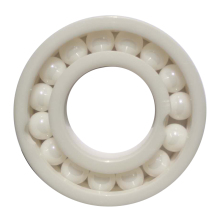Factory direct sales zirconia ceramic bearings 6202CE XINGRUIDA rolling bearing suppliers
Practical lessons have proved that as a bearing material, it must have firm specifications and sizes under various ambient temperatures, so as to ensure that the bearing is underground in the workplace where the ambient temperature changes, adhere to exquisite specifications and sizes and accurate cooperation, and have the ability of anti-corruption and anti decomposition in the underground of strange workplaces, The ceramic materials used to manufacture rotating bearing parts shall have the following functional characteristics:
1) Low density. Because the density of the rotating body is reduced and the centrifugal load is also reduced during high-speed operation, it can operate at higher speed.
2) Medium modulus of elasticity. Compared with ordinary bearings, stainless steel bearings not only have obvious advantages in material, but also are much more strict in process and precision control than ordinary bearings. In the working process, stainless steel bearings work stably, have low noise, corrosion resistance and are widely used. If the elastic modulus is too large, the bearing capacity of the bearing will be reduced due to stress concentration.
3) The coefficient of thermal expansion is small. Plastic bearings can generally be divided into plastic rolling bearings and plastic sliding bearings; The working principle of plastic rolling bearing and plastic sliding bearing can be distinguished by name. The friction of plastic rolling bearing is rolling friction, while that of plastic sliding bearing is sliding friction; The magnitude of rolling friction mainly depends on the manufacturing accuracy; The friction of plastic sliding bearing mainly depends on the material of bearing sliding surface. Reduce the sensitivity to the change of ambient temperature and make the bearing ambient temperature area wider.
4) High compressive strength. Ceramic balls are pre fired and rounded at low temperature and sintered and ground at high temperature by dry static press. However, it has been learned recently that precision should be done first, otherwise the hardness will be high after high temperature firing. High compressive strength is the premise for rotating bearing to withstand high stress.
5) High hardness and high toughness. The combination of these two characteristics can obtain a good nominal roughness; And can avoid the invasion of foreign particles and impact.
6) Excellent resistance to rotational contact loss and peeling mode.
7) Special occasions should have high temperature resistance, corrosion resistance and firmness.
The contact surface between the ferrule and the rotating body suffers from the function of external load and rotation, so it has always caused contact stress and deformation. Because of the material and functional characteristics of steel bearings, the key situation of bearing damage is loss spalling, short service life and large limit of utilization area. The ceramic material has the advantages of low density, medium elastic modulus, small coefficient of thermal expansion, high hardness, high temperature resistance, corrosion resistance and non magnetism. The ceramic ball bearing with silicon nitride ceramic ball as rotating body can significantly improve the service life of bearing contact loss, greatly expand the utilization scope of rotating bearing, and has been widely used in all kinds of high-precision and high-speed machine tools, automobiles, racing cars Subway, motor, aviation engine, petrochemical machinery, metallurgical machinery, etc.
 Audited supplier
Audited supplierThe bearing is divided into radial bearing and thrust bearing according to the nominal contact angle in the bearing direction.
According to the type of rotating body, it is divided into ball bearing and roller bearing.
It is divided into self-aligning bearing and non self-aligning bearing (rigid bearing) according to whether it is self-aligning or not.
According to the number of columns of rotating body, it is divided into single row bearing, double row bearing and multi row bearing.
According to whether the parts are separated or not, they are divided into: bearings can be separated and bearings can not be separated.
In addition, it can be classified according to the size of the structure. Plastic bearings can generally be divided into plastic rolling bearings and plastic sliding bearings; The working principle of plastic rolling bearing and plastic sliding bearing can be distinguished by name. The friction of plastic rolling bearing is rolling friction, while that of plastic sliding bearing is sliding friction; The magnitude of rolling friction mainly depends on the manufacturing accuracy; The friction of plastic sliding bearing mainly depends on the material of bearing sliding surface.
I will show you the characteristics, differences and uses of 14 common bearings. Let's study together!
1、 Angular contact ball bearing
There are contact angles between the ferrule and the ball. The standard contact angles are 15 °, 30 ° and 40 °. The larger the contact angle is, the greater the axial load level is. The smaller the contact angle is, the more conducive to high-speed operation. The single row bearing can carry radial load and unidirectional axial load. Structurally, two single row angular contact ball bearings combined on the back use the same inner ring and outer ring, which can carry radial load and bidirectional axial load.
Utilization category:
Single row: machine tool spindle, high frequency motor, gas turbine, centrifugal machine, small car front wheel, differential pinion shaft.
Double row: oil pump, roots blower, air compressor, various transmissions, fuel injection pump, printing machinery.
2、 Self aligning ball bearing
Double row steel balls, the outer ring raceway is of inner spherical surface type, so it can adjust the misalignment of the axis caused by the deflection or non concentricity of the shaft or shell by itself. The tapered hole bearing can be conveniently installed on the shaft by using fasteners, which is important to bear radial load.
Application scope: woodworking machinery, textile machinery transmission shaft, broken belt seat self-aligning bearing. Plastic bearings can generally be divided into plastic rolling bearings and plastic sliding bearings; The working principle of plastic rolling bearing and plastic sliding bearing can be distinguished by name. The friction of plastic rolling bearing is rolling friction, while that of plastic sliding bearing is sliding friction; The magnitude of rolling friction mainly depends on the manufacturing accuracy; The friction of plastic sliding bearing mainly depends on the material of bearing sliding surface.
3、 Self aligning roller bearing
This kind of bearing is equipped with spherical rollers between the outer ring of spherical raceway and the inner ring of double raceway. According to the difference of internal structure, it is divided into
R、R
H. RHA and Sr four types, because the arc center point of the outer race raceway is the same as the bearing center point and has the characteristics of centering, it can actively adjust the misalignment of the axis caused by the deflection or differential center of the shaft or shell, and can carry radial load and bidirectional axial load.
Scope of application: paper machinery, reducer, railway vehicle axle, rolling mill gearbox seat, rolling mill roller track, crusher, vibrating screen, printing machinery, woodworking machinery, various industrial reducers, broken belt seat self-aligning bearing.
4、 Thrust self-aligning roller bearing
In this kind of bearing, the spherical rollers are arranged obliquely. Because the raceway surface of the race is spherical and has the centering function, the shaft can be allowed to have several inclinations, and the axial load can be very large. When bearing the axial load, it can also bear several radial loads. Oil lubrication is usually used.
Application scope: hydraulic generator, broken electric motor, marine propeller shaft, reducer for rolling screw of steel rolling mill, tower crane, coal mill, extruder and forming machine.
5、 Tapered roller bearing
This kind of bearing is equipped with round platform shaped rollers, which are led by the large retaining edge of the inner ring. In design, the apex of each conical surface of the inner ring raceway surface, the outer ring raceway surface and the roller rotating surface intersects a point on the bearing centerline. Single row bearing can bear radial load and unidirectional axial load, and double row bearing can bear radial load and bidirectional axial load. It is important to bear heavy load and impact load.
Application scope: Automobile: front wheel, rear wheel, transmission, differential, pinion shaft. Machine tool spindle, construction machinery, large agricultural machinery, railway vehicle gear reducer, rolling mill roll neck and reducer.
6、 Deep groove ball bearing
Structurally, each ring of deep groove ball bearing has a continuous groove raceway with a cross section of about 1 / 3 of the circumference of the equatorial circle of the ball. Compared with ordinary bearings, stainless steel bearings not only have obvious advantages in material, but also are much more strict in process and precision control than ordinary bearings. In the working process, stainless steel bearings work stably, have low noise, corrosion resistance and are widely used. Deep groove ball bearing is mainly used to bear radial load and certain axial load.
When the radial clearance of the bearing increases, there is the nature of angular contact ball bearing, which can bear alternating axial loads in two directions. Compared with other types of bearings with the same size, this type of bearing has small friction coefficient, high limit speed and high precision. It is the preferred bearing type for user selection.
Application scope: automobile, tractor, machine tool, motor, water pump, agricultural machinery, textile machinery, etc.
 Audited supplier
Audited supplier
Factory direct sales zirconia ceramic bearings 6202CE XINGRUIDA rolling bearing suppliers

Zirconia ceramic bearing 6200CE high temperature bearing xingruida bearing supplier

Ceramic bearing ceramic structural parts Xingruida bearing supplier

Zirconia full ball ceramic bearing 6205CEF Xingruida corrosion resistant bearing supplier

Factory direct supply deep groove ball bearing 6205-2RS Xingruida rolling bearing custom

Thrust ball plastic bearing 51206 pom Xingruida flat plastic bearing supplier

Manufacturer direct-selling Hybrid Ball Ceramic bearing 6203CE XINGRUIDA bearing supplier

Factory direct export spherical ceramic bearing with seat Xingruida Zirconia ceramic bearing suppliers

Angular contact ball bearing zirconia ceramic bearing 7205CE XINGRUIDA bearing machine tool ceramic bearing factory








